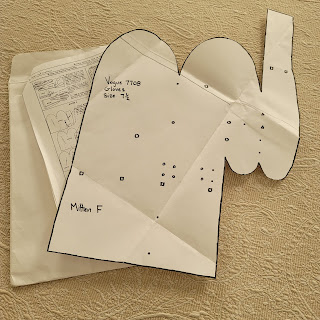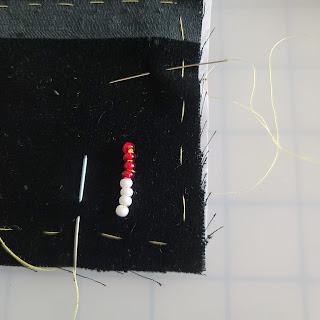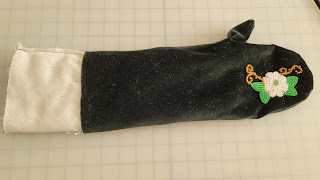Companion YouTube Video: https://youtu.be/CKVgMmdvKus
November 2021 was proclaimed National Native American Heritage Month by President Joseph R. Biden.
In a blog post and video that same year I shared with you my Native American ancestry including a bit of history of the my ancestral tribe, the Lac Courte Oreilles Band of Lake Superior Ojibwe near Hayward, Wisconsin.
Blog Post: https://theperfecttouchvictorian.blogspot.com/2021/11/native-american-heritage-month-ancestry.html

Believing that a wonderful way to exchange cultures is through sharing food, I made Strawberry and Cherry Wild Rice Tarts served with Ojibwa Tea.
This year I would like to share with you the beginning of my journey into what I believe is another wonderful way to share cultures - art. Although Native American culture is rich with many art forms, I have chosen beadcraft.
Beadcraft has a long history in Native American culture and characteristic designs often differentiate the beadwork of one tribe from another. The Ojibwe tribe beadwork is characterized by florals and other items native to the surroundings.
Jessica Leigh Gokey is a Master Beadwork Artist. I'll share a link to her website.
She is a member of the tribe of my ancestors, the Lac Courte Oreilles Band of Lake Superior Ojibwe. Jessica says "It is through my beadwork that I keep Ojibwe traditions alive by incorporating Ojibwe floral patterns. I strongly believe that sharing my knowledge of traditional Ojibwe beadwork helps to preserve a traditional art form for future generations."
Among numerous awards and recognition Jessica has recently had her art "A Dance with Florals" (which you can see on her website) chosen to be on exhibit in the US Embassy to the Holy See (The Vatican) in Rome, Italy as part of the Art in Embassies Program.
I decided to begin my journey into Ojibwe beadwork in an online class taught by Jessica. Sadly the web hosting company closed before I could complete my study. But Jessica had also published an online book which I purchased and studied.
I also found a book by Pamela Stanley-Miller with bead weaving and applique patterns from Native American artifacts found in museum collections throughout the United States.
With the research and study well underway, it is time to begin my first real piece of wearable beadwork. The weather is cooling and I need a new pair of mittens. I have Vogue 7708 which includes a one-piece mitten pattern.
I have some black velveteen left over from my 1930s wardrobe project and a bit of white curly textured fabric from the Victorian Holiday Barbie project 2021. Mittens will be a good use of these fabric scraps. (Yep, looks like an elephant to me too!)
Jessica Gokey has taught me the steps she uses to create her beautiful art. The first step will be drawing the design. While museums still hold pieces of birch bark templates used to create designs, more modern materials would be cardboard, or, as I've used, tissue paper. A tissue paper pattern can be created and folded and traced for a reverse. Jessica has provided pages of some of her individual designs for her students' use and I design a Dogwood Blossom with leaves and branches.
The design is then copied to Stitch-N-Tear Stabilizer and the edges of the mitten marked for placement.
The Stitch-N-Tear is placed on top of the velveteen and an interfacing on the bottom. All three layers are basted together.
With my design drawn and my fabric ready, it is time to choose and test beads. Natural materials would have been used by Native Americans including shells, quills, metals, and stones. All would have been shaped for use. With the arrival of the European settlers came glass beads from Italy. These first glass beads were called pony beads and were much larger than beads used today. The smaller glass seed bead, an import from Czechoslovakia, became popular around 1850 and remains a favorite.
To practice beading on velveteen and to determine what size beads will work for my design, I baste together a small piece of velveteen and interfacing.
I have some beading needles and pre-waxed beading thread left over from my beaded reticule projects years ago. My ancestors would have used sinew, the tough, fibrous, connective tissue of animals, to string their beads. I also have some 6/0 beads on hand and some much smaller 11/0 which are the perfect green for the center of my Dogwood Blossom.
In my studies I've learned several stitches for applique beadwork and begin with the two needle method. The beads are strung on a needle with a double thread and then a needle with a single thread is used to tack the beads down between each bead and over the double thread.
The 6/0 beads do not curve well to outline my design so I search through my leftover beads and experiment with other 11/0 smaller beads.
While the 11/0 beads curve nicely I don't have a beading needle thin enough for them and have to sort through them to find beads with larger center holes. So it's off to the craft store for thin beading needles and because there was a 50% off sale (yay!) I find the perfect colors in size 8/0. A bit larger than Jessica recommends but I think it's a perfect size for my first real project and I love the way they curve.
Now I'm ready to begin.
For my first beaded mitten I used the two-needle technique with the pre-waxed thread and bead the entire design over the Stitch-N-Tear.
Now I can remove the basting and the Stitch-N-Tear. I am instructed to use an Xacto knife to cut away the Stitch-N-Tear but I'm a bit nervous about damaging the velveteen so I cut away the main excess with a scissors and use a tweezers to remove the remainder. The Stitch-N-Tear is left under the leaves and blossom.
At this point I am more than happy! Is it perfect? Heavens, no! Am I thrilled to have done it? Yes!!
A few extra brown beads as I've seen done on other beadwork adds interest to the single lines of brown beading.
The second mitten gives me a chance to try using a cotton thread and wax, and to remove the Stitch-N-Tear after just beading an outline and then filling in the leaves and blossom directly on the velveteen.
The beads were difficult to place directly on the nap of the velveteen without the Stitch-N-Tear and I don't care for the bits of black showing through the blossom or the leaves. But I do love the outline effect and may use that in future projects. Although the blossoms are not identical on both mittens I decide to be happy with my efforts.
Now it's time to sew the mittens and linings.
The lining is slipped into the exterior and the seam allowances turned in at the edge and slipstitched together. The cuff is turned.
Finished Dogwood Blossom Beaded Mittens
It's November and not quite cool enough for these cozy mittens but soon...
Laying on the Dogwood tree which is now completely bare of blossoms or leaves. But the beaded Dogwood Blossoms will remind me that in the cool and quiet of winter is the promise of a glorious spring.
The Next Project
As you have probably guessed I haven't gone through all this research, study, and practice just for a pair of mittens. While I do love them and will use them daily, they are the beginning of a very special project. My Native American ancestry began with the birth of my ancestor, Mary, in 1862 to a fur trader and an Ojibwe woman. I have found a pattern based on an 1862 coat from Frank Leslies' Magazine offered by Harriet's Patterns.
But that is for another blog post and video. Thank you for sharing this journey with me!
Hugs,
Jeanette
The Challenge: March: Non-Woven. Make something not based on woven materials. There’s a whole world of possibilities. Braiding, carving, crocheting, felting, knitting, knotting, naalbinding…and…
With glass beads created in Italy in the early 1500s and beads from Czechoslovakia available in mass production and popularity in the 1850s, it seemed that these were a non-woven alternative to garment embellishment in historical fashion.
Material: Cotton velvet, faux fur, interfacing
Pattern: Vogue 7708
Year: To be paired with an 1862 coat
Notions: Glass beads and beading thread
How historically accurate is it? The bead design is created using historical Ojibwe inspiration.
Hours to complete: 10 hours
First worn: During the Winter Storm Elliott of December 2022
Total cost: $5
.jpg)


.png)
































































































No comments:
Post a Comment